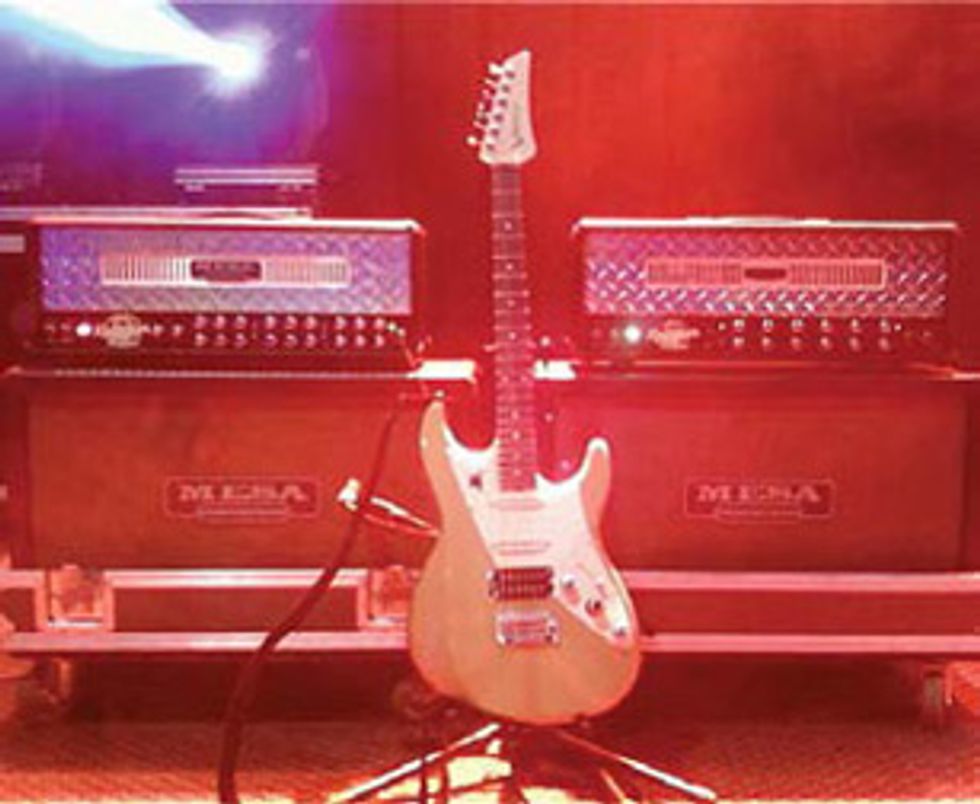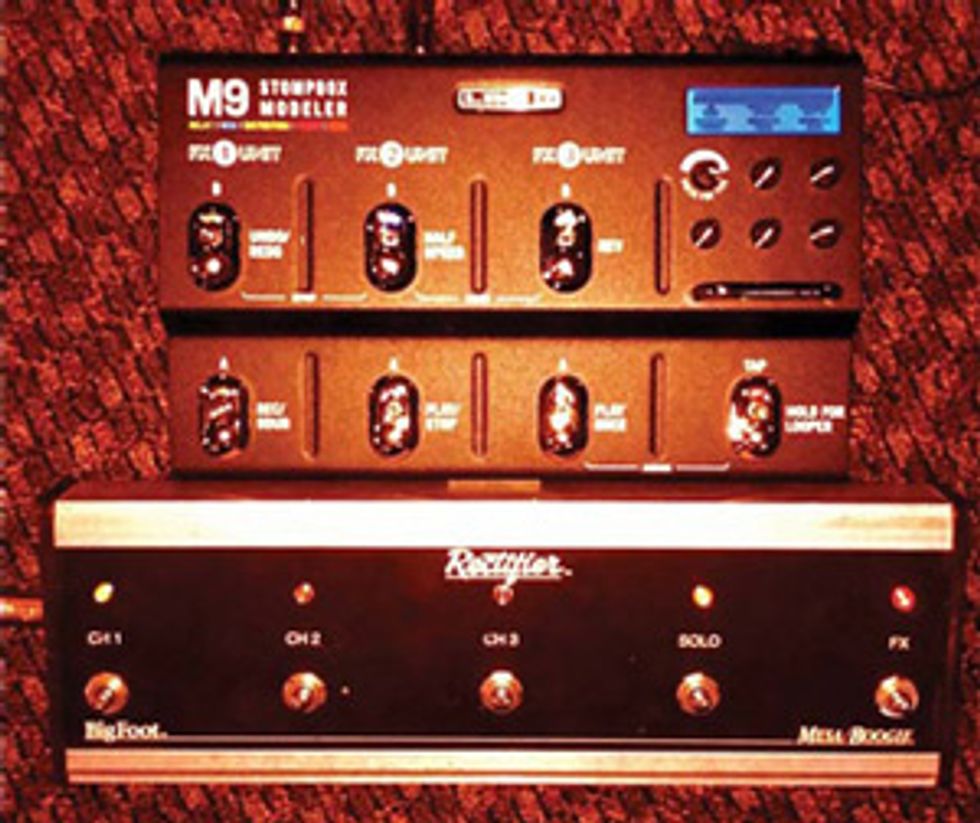

LEFT: A Line 6 James Tyler Variax and two Mesa/Boogie Dual Rectifiers going through
a pair of 2x12 Mesa Rectifier cabs loaded with Celestion Vintage 30s.
RIGHT: A travelfriendly Line 6 M9 rests against a Mesa/ Boogie Big Foot
footswitch that provides channel switching and solo boosts.
“I didn’t play well because my guitar setup felt weird.” “I was having an off night because the rental amp didn’t sound good.” I hear these excuses far too often. As a player, it’s your responsibility to be on top of your gear, and in the professional world, it’s crucial to know how to deal with such issues. Like it or not, it is up to you to know how to get the most out of any guitar or amp you come across. The two most common brands of amps I find on stages full of backline gear are Fenders and Mesa/Boogies. Lets begin with some tips on settings for these amps.
The first thing I do on a Dual Rectifier is turn off the bass on my rhythm channel. The majority of the gigs I do require a crunch sound that has a little bit of dirt on the attack and a clean bloom. Removing the bass allows this to happen on a Dual Rectifier because the low-end rumble is dialed out. Next, I dedicate a separate channel on the Dual Rectifier for solos. Unlike the rhythm channel, I add a considerable amount of bass for lead sounds. Solos involve a lot of single-note phrases, so the bass adds support and body to the tone.
On Fender amps, especially blackface and silverface models, the first thing I do is turn off the treble and the bright switch. From there, I will add treble back in, little by little as needed. Taking the treble out of the equation and pushing the volume makes blackfaces break up in an organic way. Blackface and silverface Fenders can be bright to begin with, so turning off the treble is not as radical a move as you might think.
With other amps I’m less familiar with, I’ll start with everything at 9 o’clock, except the master volume, which I usually run pretty hot. From there, I’ll give each knob a full sweep and listen for the evenness of the tone pots. I look for the spot where the knob really kicks in and evaluate where it stops making a difference. A lot of tone pots don’t sound very different beyond a certain point. If an amp is still lacking a needed frequency, I’ll turn to my Line 6 M9 to beef up the tone.
Because it has every sound I would ever need on a commercial gig, the M9 is great for “fly dates” and situations where I don’t have my own amp. Plus it easily fits in my backpack—a real benefit. Sometimes I’ll use the M9’s EQ in the amp’s effects loop if an amp is missing a vital frequency. Using the effects loop puts the M9’s EQ after the preamp tubes in the signal path, so you can make tonal tweaks before you hit the amp’s power section.
Another Line 6 product that makes fly dates much easier is the James Tyler Variax. If you’re in a band that uses a lot of different tunings and sounds, you need to check out this guitar. The Variax comes in handy because pretty much everything I’d ever need sonically is loaded in the guitar. A few years ago, I used to fly with two electrics, a banjo, an acoustic, and a pedalboard. One electric would be dedicated for standard tuning and the other would be tuned a half-step lower to Eb. I only had to play banjo on one song and acoustic on a couple songs. Now, I just take the Variax and I can make all of those sounds happen with one instrument instead of dragging four cases through the airport.
Another reason I use the Variax is for its tuning abilities. The guitar has a rotary wheel that gives me immediate access to standard tuning, drop D, E% standard, open G, baritone tuning, and several others with the flick of a switch. The strings themselves are not changing tension, but the DSP in the guitar’s electronics instantly converts the strings’ amplified pitch based on the setting I choose. Because the guitar always remains in standard tuning, I don’t have to worry about the neck flexing and the intonation getting out of whack. Great!
Many modern electric guitars, like the Variax and the PRS Hollowbody series, are outfitted with piezo pickups and other forms of acoustic simulators. Whenever I use an electric guitar’s piezo pickup or the Variax’s acoustic settings, I run the guitar into an A/B box. This allows me to split the “acoustic” sounds into a DI that goes straight through the PA, and run the electric output into my amp. Acoustic modeling typically doesn’t sound very good through an amp that’s dialed in for electric tones, so using an A/B box is a good way to have the acoustic tones run down a separate line.
Several companies are making compact amp heads and direct digital modelers that sound fantastic. I recommend a great deal of research on different types of gear so you have a couple key pieces of equipment to help you get “your sound” in any situation. Once you have those items squared away, you can have peace of mind about your gear and get back to focusing what’s most important ... playing!















![Rig Rundown: Russian Circles’ Mike Sullivan [2025]](https://www.premierguitar.com/media-library/youtube.jpg?id=62303631&width=1245&height=700&quality=70&coordinates=0%2C0%2C0%2C0)








